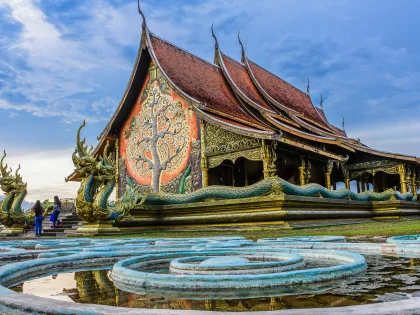Founded around 2,500 years ago, and with devoted believers in most Asian countries, the Buddhist religion continues to be highly influential in Thailand and elsewhere. Buddhist temples are sacred spaces where people come to pray, pay respects, and practise their faith.
These beautiful temples welcome visitors from around the world, and understanding how to dress and behave appropriately helps create a respectful atmosphere for everyone. The following guide will help you feel confident about what to wear in Thailand temples and how to show respect during your visit.
Dress Modestly And Respectfully
When visiting temples in Thailand, understanding what to wear in Thailand temples is essential for showing proper respect. Both men and women should choose a Thailand temple outfit that covers most or all of the body.
For the Thailand temple dress code for male visitors, shirts should have sleeves, and trousers should cover beyond the knees. Avoid tank-tops and short shorts. For women, the Thailand temple dress code for women follows similar guidelines - modest clothing that covers shoulders and legs appropriately.
We understand that Thai weather can be quite warm, and sometimes there's barely any breeze, but dressing appropriately for these holy spaces is deeply appreciated by locals. A suitable temple dress simply needs to be respectful and modest, and you'll find many beautiful options that are both comfortable and appropriate.
Temples are sacred spaces meant for quiet respect. While hats, sunglasses, and sandals are welcome, please wear clothing with tasteful designs. Avoid prints or slogans that include references to sex, violence, religion, or drugs. With a bit of care in what you wear, you’ll enjoy a meaningful and respectful visit.
The dress code Buddhist temples follow also includes showing respect to monks and Buddha statues when you see them. Thai people have a distinctive gesture called 'wai', which serves to signal respect. The action involves putting your hands together, fingers pointed upwards, while slightly tilting your head and body forward. There are other forms of showing respect, such as standing still when in the presence of a monk, or bending the body forward slightly when walking past.
Keep Noise Levels Low and Be Considerate
Temples are wonderfully serene spaces, and maintaining a quiet, respectful atmosphere helps everyone enjoy their visit. Speaking softly, refraining from touching things unnecessarily, and moving mindfully through the temple creates a lovely environment for prayer and reflection. If you're visiting with children, it's perfectly natural if they become a bit restless - simply stepping outside for a moment can help them settle and is considerate to others. Using gentle, respectful language throughout your visit shows consideration for the monks and other visitors who come to pray and practise Buddhism.
Respecting Sacred Spaces and Traditions
Thai temples have some beautiful customs that are easy to follow once you learn about them. Generally, it's best to admire sacred items with your eyes rather than touching them, unless the temple specifically invites interaction with certain pieces. When entering temple buildings, you'll notice a raised threshold at the entrance - simply step over this rather than stepping on it. This is a traditional sign of respect that locals appreciate.
For female visitors, it's worth knowing that monks follow strict guidelines regarding physical contact with women. If a monk accidentally has physical contact with a female visitor, they must undergo a lengthy cleansing ritual, so maintaining a respectful distance is very much appreciated. You'll also want to remove your shoes before entering sacred spaces - you'll often see designated areas for footwear near entrances.
Understanding Temple Etiquette
The Thai temple dress code includes some customs about body language and positioning. When sitting inside temples, it's important to be mindful of where your feet are pointing. In Thai culture, feet are considered the lowest part of the body, so pointing them towards monks or sacred objects isn't appropriate.
Simply keep your feet close to the ground and avoid raising them to higher positions, especially when monks are present. These gentle guidelines help create a respectful environment that honours Thai traditions.
The Thailand temple dress code and these cultural practices might seem new at first, but it is important to be mindful to show respect. Thailand's temples are beautiful and deeply spiritual places that offer incredible experiences for visitors who approach them with genuine respect. Once you understand these customs, visiting a Buddhist temple can be truly enjoyable, fascinating, and educational. Those seeking spiritual experiences will find that these sacred spaces can offer profound moments of reflection and peace.









Share-
-
-
-
URL copied to your clipboard